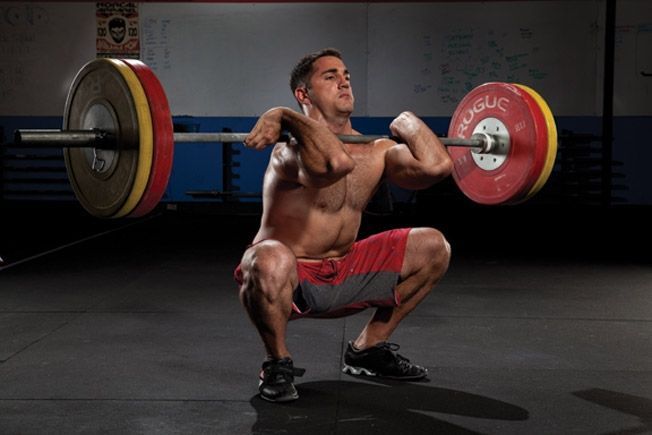We continue the section dedicated to 9 fundamental movements of the CrossFit® and in this 2 EP, we will talk about the Front Squat.
This is an exercise that mainly involves the quadriceps, the upper back and the core which must be active to avoid overloading the spine.
It is not a movement to be performed by a novice as it requires considerable skill force general and good mobility.
In your crossfitter career, learning this exercise to perfection is essential as it is the basis for performing more complex exercises such as i thrusters and of clean.
Index
HOW TO PERFORM THE FRONT SQUAT
1) FRONT RACK
The front squat includes the support of the barbell in FRONT RACK that is on the clavicles and on the hands. THE elbows must be tall.
2) STARTING POSITION
To start the exercise you need to detach the bar from the rack, to do so I always recommend only 3 steps, the first to move away from the rack, a second to set the stance and a last step to complete the starting position. Further steps would only result in a waste of energy.
3) EXECUTION
- Look forward, chest out, elbows high.
- I carry out the trudge by bringing the hips back and down.
- During the squatting, despite having an overload moved forward compared to my center of gravity, it is necessary to keep the back well extended.
- During the descent and ascent, keep the centrality remaining as vertical as possible with the torso.
POSSIBLE ERRORS
-
ELBOWS
This error is widespread and depends on poor mobility of the back and shoulder, so pay close attention to it.
-
DETACH THE HEELS
In the Front Squat the weight is resting on the front rack so the tendency is to break away by detaching the heels.
This error may be due to poor mobility of the ankle or incorrect technique.
-
LOSE THE BACK OF THE BACK
Because of the weight it can happen that during the execution the extension of the vertebral column is lost, overloading it. This error is due to a core that is not strong enough for the weight used.
The errors just seen are absolutely not to be overestimated as they can result injuries to the elbows, wrists, hips, knees and finally also to the spine.
EDUCATIONAL PATH TO BE FOLLOWED
To learn this exercise in the best way it is essential, before approaching the front squat, to succeed in execute perfectly theair squat.
And, as mentioned above, the front squat requires not only strength, but also the right mobility of the wrists, elbows, shoulders, chest for the front rack and then the hips and ankles to perform the squat.
PROGRESSION TO LEARN THE FRONT SQUAT
-
PVC:
The first approach with this exercise must be with PVC so that you don't have an overload and focus solely on the execution and see what the critical points are.
-
DBS F.SQUAT
After trying to perform this exercise with PVC you can start using two dumbbells that unlike the barbell are easier to support in the front rack and help to increase the mobility of this position.
-
CROSSED ARM F.SQUAT
The first approach of the front squat with a barbell recommend running it in the "crossed arm" mode. Running with crossed arms reduces the need for mobility and this allows you to focus exclusively on the technique of execution.
-
TIMETABLE
This variant allows you to pay attention at every stage of the squat without running away from the most complicated moments and also helps to increase strength.
-
SQUAT
If you have followed the right progression you should be able to perform the complete exercise with a barbell.
It is very important at this stage not to proceed too quickly and progressively increase the weight to avoid technical errors and accidents.
Here is the video tutorial:
https://www.instagram.com/p/B2ZaeNWhf0D/?utm_source=ig_web_copy_link











